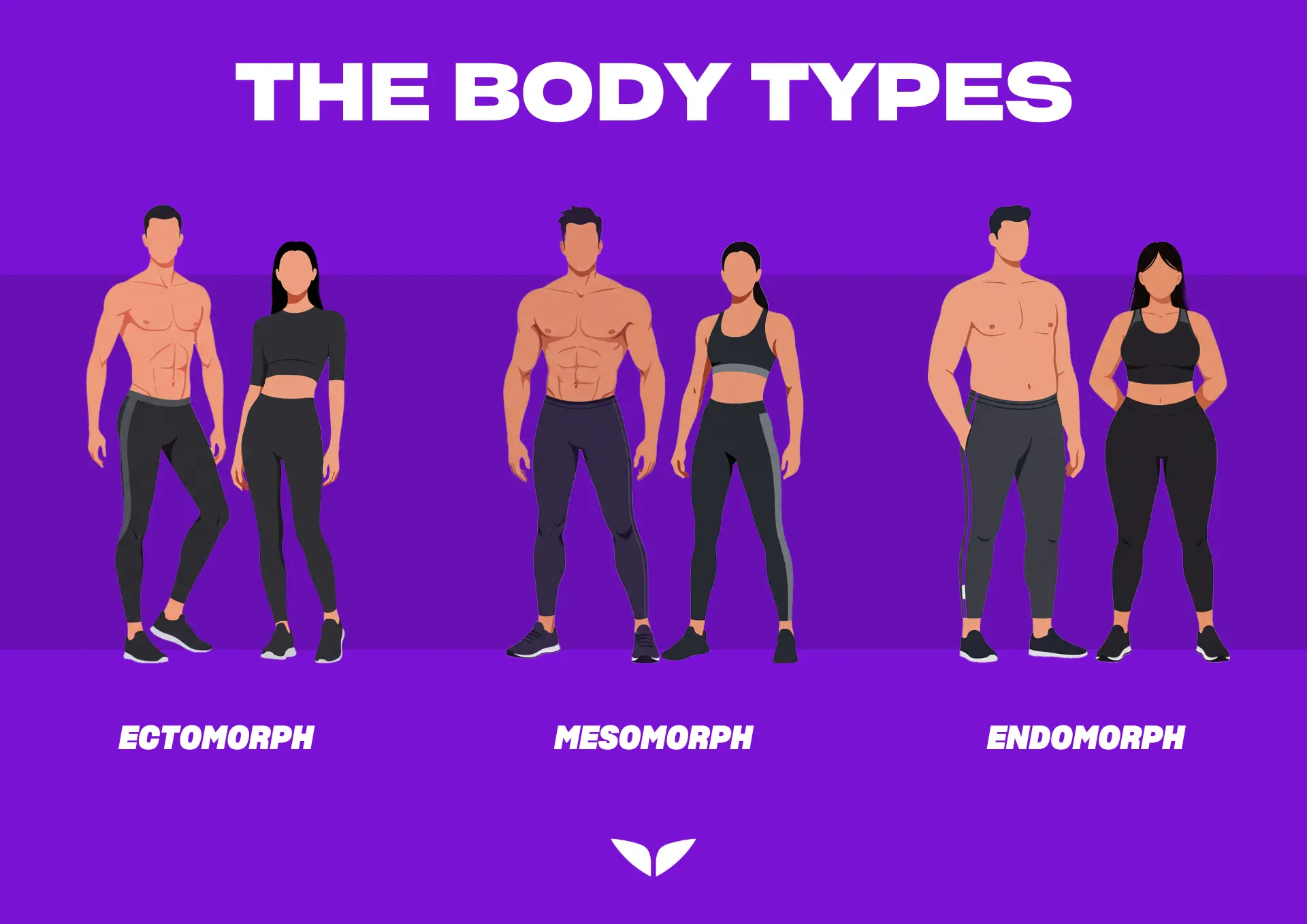Improving health and fitness is one of the most important places to start when creating an extraordinary life. But different body types require different routines.
You want to choose exercises and diets that fit your particular body. And knowing your individual body type can help you optimize your health.
How many different body types are there?
Both males and females come in all kinds of shapes and sizes. So when it comes to the different types of bodies, they are categorized into three.
This concept was introduced by William Herbert Sheldon, a physician and psychologist, who analyzed thousands of photographs to determine similarities in the human physique. He concluded that there are three general body types, which he called somatotypes.
What are the different body types?
The three body types are ectomorph, mesomorph, and endomorph. Everyone falls into one of the three categories, and your ideal health and fitness lifestyle depends on which group you’re in.
Wondering which one you are? Let’s explore each body type name in closer detail.
1. Ectomorph
Ectomorphs are relatively lean, wiry body types with narrow frames and long limbs. They have difficulty building muscle and, as a result, are usually more inclined to excel at cardiovascular activities.
They often have a fast metabolism, which allows their bodies to burn calories rapidly. As a result, they’re often quite lean without much body fat.
Ectomorph diet
Should an ectomorph pile on the calories if they’re looking to gain weight? Well, not exactly.
Adding more calories to your diet can help you put on the pounds. But this doesn’t mean you should stock up on junk food.
There are ways to increase your caloric intake by eating more healthy fats and proteins like meat, fish, nuts, and seeds.
A small snack or meal before sleep may also help. By eating before they go to bed, those with an ectomorph body type can prevent muscle catabolism.
Ectomorph workout
What about an ideal ectomorph workout?
At the gym, an ideal routine for an ectomorph will be intense and short.
The name of the game is quick sessions to get your muscles going without putting your metabolism into overdrive. In addition, the workouts should focus on large muscle groups, like the glutes, quads, hamstrings, and core.
2. Mesomorph
With their exceptional muscle mass, large bones, and rectangular shape, mesomorphs are hard to miss. These natural athletes excel at just about any physical activity they take on.
Mesomorphs have the ability to lose or gain weight, depending on their fitness goals.
Mesomorph diet
A sensible balance of protein, complex carbs, and healthy fats is what will help mesomorphs get the most from their bodies.
This diet, coupled with a mix of cardio and targeted weight training, will yield the best results.
Mesomorph workout
Their bodies take well to both cardio exercise and weight training. But mesomorphs still need proper training and nutrition to achieve the results they’re looking for.
3. Endomorph
Endomorphs are often shorter than the other two body types. They have thick legs and arms with rounder bodies. Overall, you may describe them as stocky.
Nevertheless, endomorphs are strong, particularly in their legs. They gain muscle quite easily but can also easily gain fat, which can be tricky for them to lose. The reason for this lies in a slow metabolism, so a sensible diet is an absolute must.
Endomorph diet
Because endomorphs have a slower metabolism, it’s easier for their bodies to convert carbohydrates to fat than other body types. Their best diet consists of plenty of healthy fat and protein. You might choose to follow a diet similar to paleo.
Prioritizing healthy fat and protein foods in your diet means that you can have more lean meats, high-protein vegetables, nuts, and eggs.
Avoid all processed foods like frozen meals, simple carbs like pasta or white bread, and fatty butter similar to margarine. The best way to consume carbohydrates is to go for complex carbs like fruits, starchy vegetables, and whole grains.
Endomorph workout
Endomorphs benefit most from planned workouts that are designed to expedite fat burning and define muscles. Weightlifting plus cardio is usually the winning combination.

How can you identify your body type? (+ free quiz)
You can discover how to know your body type by evaluating yourself objectively. You can also try our body type quiz below but a quick look in the mirror works too.
Everyone has different types of bodies, so set aside how you feel about your appearance and be honest with yourself.
Start with your physique. Are you tall, average, or short? Are you lean, round, or plump?
Next, think about how your body responds when you eat and exercise. Do you gain weight easily? Do you have trouble building muscle?
These are the traits to look for in your type of body build:
- Ectomorph. You have almost no body fat, a wiry frame, and long slender limbs.
- Mesomorph. You have a proportionate figure with a balance between muscle and fat.
- Endomorph. You have a stocky frame and large, powerful legs.
Can you be a combination of two body types?
There’s no one-size-fits-all when it comes to different types of body builds. In fact, many people are a combination of two body types: ecto-meso and meso-ecto.
The ecto-endo combo, however, is less common because it’s usually acquired due to behavior, such as poor eating habits and a sedentary lifestyle.
What are body types for females?
Like males, females can be categorized into ectomorphs, mesomorphs, and endomorphs. The characteristics are similar as well.
Female ectomorphs
Female ectomorphs find it hard to gain weight. They have a narrow body frame with thin arms and legs. Cameron Diaz is a great example of an ectomorph type.
Female ectos should always protect their joints while exercising. However, regular cardio combined with high-intensity interval training (HIIT) can do wonders for their physique.
Strength training is also a good option, as it helps them build muscle around their lean frames.
Female mesomorphs
Mesomorphs, on the other hand, have naturally curvy bodies with well-defined muscles. They are known to gain muscle quickly, and HIIT training can be an effective way to streamline both their cardio and strength training interests.
A great example of a female mesomorph? Look no further than Jessica Biel or Salma Hayek.
Female endomorphs
Endomorphs are typically pear-shaped and have narrow shoulders coupled with wider hips.
Like their male counterparts, female endomorphs gain fat quickly and have a slower metabolism. But they can use a combination of weightlifting and HIIT to shed excess fat and build more muscle.
A quick look at Beyoncé is enough to highlight the typical female endomorph body.
What are body types for males?
The male body types are categorized into the same patterns: ectomorphs, mesomorphs, and endomorphs.
Male ectomorphs
Those with an ectomorphic body type have a lean body and a narrow chest with little to no body fat.
Think of Crazy Rich Asians‘ Henry Golding to picture this body type.
Male mesomorphs
They usually have athletic bodies, somewhere in the middle of ectomorphs and endomorphs. Their bodies are strong and muscular.
A great example of this body type is Chris Hemsworth.
Male endomorphs
The male endomorphs have a body type completely opposite from the male ectomorphs. They may have less muscle definition and more body fat.
However, with the right diet and a proper fitness routine, they can keep their bodies in great shape.
An example of a male endomorph is Tyler Perry.
Make a change, create an impact
Determining your body type can help you better understand how your body works and what it needs. But in the quest for greater health, we need more than just a healthy diet and exercise routine.
We aren’t sure how to tell if someone’s healthy or not. But we know so much about diabetes, Alzheimer’s, and obesity. In other words, we live our lives in pursuit of managing our diseases rather than our health.
— Ronan Oliveira, trainer of Mindvalley’s 10X Quest
It’s a journey that requires perseverance, stamina, and willpower. But it will lead you to the realization of your full physical potential.
If you need some guidance along the way, Mindvalley can come to help you. With the guidance of fitness experts Ronan Oliveira and Lorenzo Delano in the 10X Quest, you can take your body and health to the next level.
By unlocking your free access, you have the chance to sample out classes from this program and many others to upgrade your fitness routine and overall well-being.
Welcome in.









